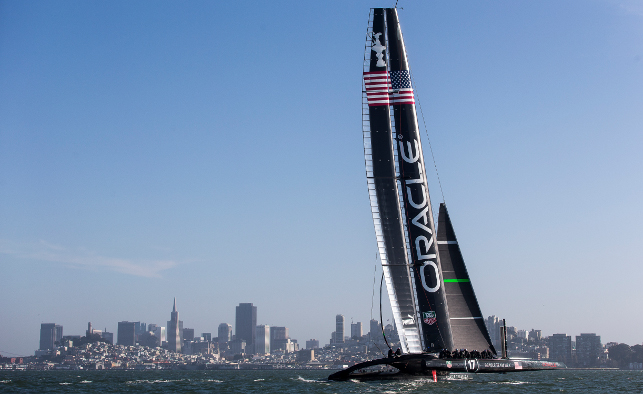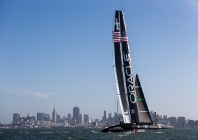King of the seas
The America’s Cup is the oldest active trophy in any international sport, a title so prized that the design and technology involved are some of the most cutting edge.

The AC72, a 40-metre tall wingsailed catamaran
2013 is set to be one of the most exciting yet, as a new class of boat, the AC72, a wing-sailed catamaran, takes to the seas of San Francisco Bay for the final races.
Current holders of the cup, Oracle Team USA, are still favourites in many people’s opinion to retain the trophy despite some high-profile setbacks. Capsizing the 40 metre tall catamaran in October in the middle of San Francisco Bay caused such damage that it resulted in a four-month development setback.
However, this delay has been overcome by some expert design and simulation, which can put other industries to shame through the incredible speed and manoeuvrability these vessels can achieve under solely wind power.
The giant wing sail is similar to the wing of an aeroplane, with its hard surface generating more power and less drag than a soft sail equivalent, allowing it to reach top speeds in excess of twice the wind speed – nearly 40 knots at its maximum.
“After the AC72’s capsize, we’ve seen how crucial it is that every member of our team be involved in reviewing and adjusting the AC72’s design, sharing their expertise and direct experience to help the catamaran perform better,” says the team’s structural design senior FEA analyst Christoph Erbelding.
The team worked using a wide range of Dassault Systèmes 3D design tools to help virtually test every aspect of the AC72’s design before committing real-world resources to building it.
3D models and simulation help the boat’s crew quickly and easily review designs in a realistic virtual environment.
Using digital manikins to simulate how team members would interact while they manned the boat also saves time.
“We need a strong, reliable solution that allows the entire team – including sailors and designers – to show the full model in meetings, zoom in to highlight certain parts, simulate how they would work, give feedback and make changes in real-time.
As a result, we cut our drafting time by almost 50 per cent,” says Erbelding.
Residential rotor
For those of us wanting to do more to advance our ecological credentials, wind power is a great year-round green solution.
As wind farms increasingly divide opinion on their suitability, perhaps the answer is to take wind power into a domestic level.
Although the small, innovative turbines designed by Enbreeze are not enough to solely power the army of power-hungry appliances found in the average home, they can reduce reliance on mainline power.
Small and designed with delicacy and silence in mind they fit into their environment with little fuss.
This next generation of small wind turbines has been developed to provide clean energy even at low wind speeds, predominantly due to its super efficient design.
Everything in the design has been designed to operate at the maximum efficiency while being as small as possible – all done through the calculations of forces on components.
From this data the engineering can then be reduced in size as much as allowed to create a truly domestic turbine that needs much less maintenance.
Developed in conjunction with fellow German design company Aero Works, the blades are the result of fine-tuning original designs.
Specialists in developing models using advanced proprietary CFD software, Aero Works helped tune the design to achieve an improved simulated efficiency by 53 per cent, while the design remained robust enough to meet the demands placed on a small wind turbine.
From the engineered models the cosmetics were then adjusted to make the turbines as aesthetically attractive as possible – reducing the ‘footprint’ of the design and lessening shadows cast from it.
From this prototype models were produced, making the Enbreeze models ready for testing and a future of producing clean energy on a local scale.
Sailing away with power
As the Americas Cup shows, sail power has by no means been weakened by the ages, so an enterprising British design firm has harnessed it to generate electricity..

Tradewind Turbines concept is a blend of sail technologies and traditional windmills.
The three sails of the rotor head, which rotate around a vertical axis, are synchronised to present maximum cross-sectional areas on the downwind sector, and aerofoil-like or minimal sections on the upwind leg.
Each sail acts downwind, like a sailboat’s spinnaker, but turns to run upwind like a ‘close hauled’ sail.
The large drag areas mean power can be generated in very light winds, but as the wind strengthens, the sails can be furled away, like on a boat, to minimise exposure and protect the structure.
The drive generators can produce electricity or alternatively the high torque generated can directly drive mechanical devices such as pumps for fluids or gases.
Setting off with markers, a whiteboard and camera, the team brainstormed and refined specific components and assemblies on the board, producing section and isometric views for first concepts.
The concept was drafted across into SolidWorks to check initial geometries, fit and function before a first off prototype was built.
The turbine was carefully modularised during the initial design specification phase. As such the team have a broad top level framework into which the detail designs need to be developed.
Working with University of Exeter they attracted a recent PhD graduate with very high calibre CFD skills, Dr Ash Majithia, who used the University’s Ansys software to simulate the interactions of the sails as they are powered by the wind.
These valuable simulations should help the team leapfrog ahead with further design developments in due course.
A pre-production prototype now in testing and approval stage, proving that adjustable sail power is a modern source of clean energy.
A look at some innovative products and devices powered by wind
Default






